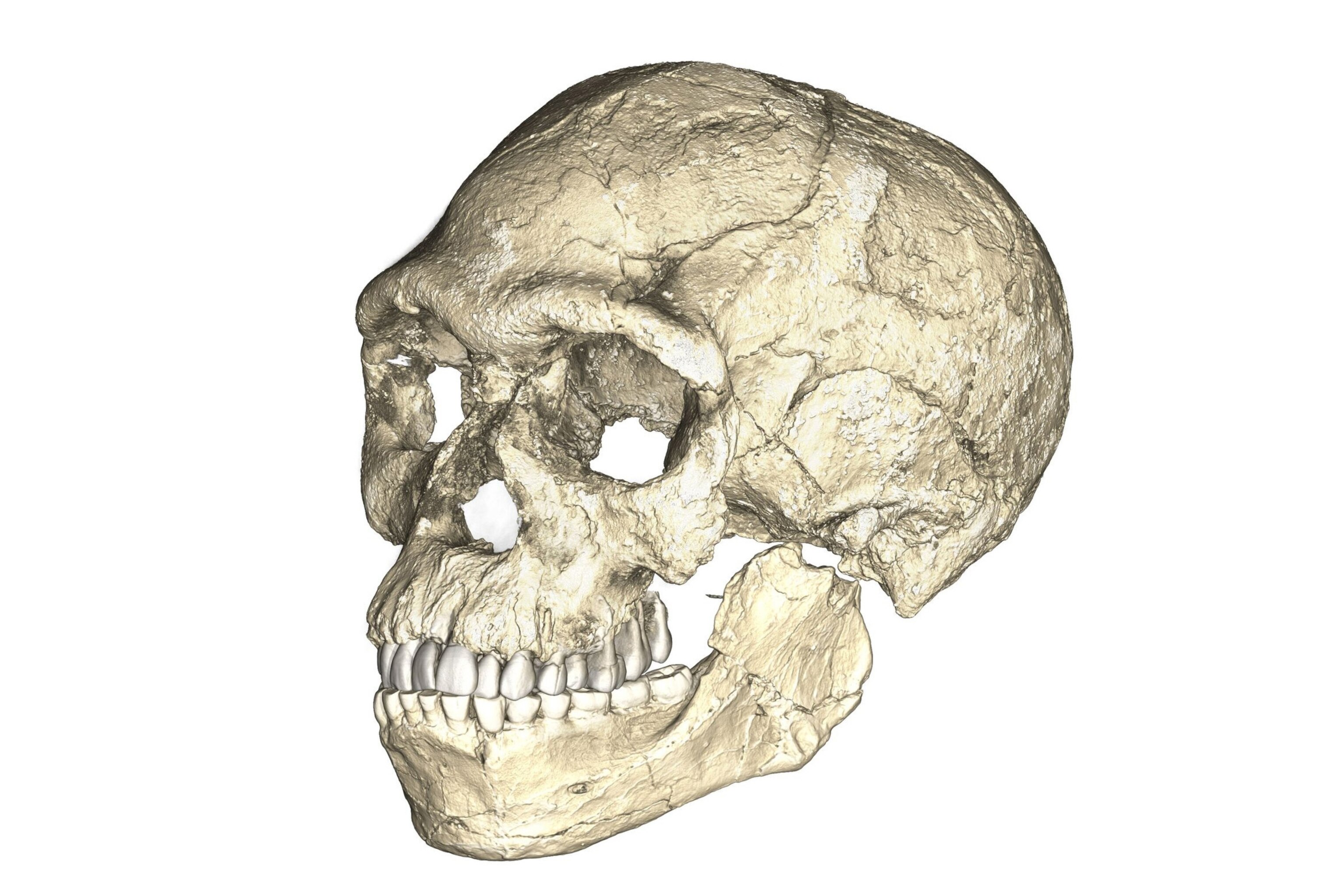





These Early Humans Lived 300,000 Years Ago—But Had Modern Faces
Some modern human traits evolved earlier, and across wider swaths of Africa, than once thought.
On a tree-speckled savanna in what’s now Morocco, a group of early humans once huddled near a fire, their stone tools scattered around their campsite.
Now, examinations of fire-baked tools from the site suggest that these ancient people lived more than 300,000 years ago, making them twice as old as previously thought.
The findings, announced in Nature on Wednesday, fill a crucial gap in the human fossil record. That’s because these people bear many striking similarities to modern humans even though they lived well before what may be the oldest fossil evidence of Homo sapiens, from a site in Ethiopia dated to about 195,000 years ago.
The residents of the Moroccan site weren’t quite the Homo sapiens of today; their skulls were less rounded and more elongated than ours, perhaps signaling differences between our brains and theirs. However, their teeth closely resemble those in the mouths of modern humans—and their faces looked just like ours.
“The face is the face of somebody you could cross in the metro,” says Jean-Jacques Hublin, the paleoanthropologist at the Max Planck Institute for Evolutionary Anthropology who led the new research. “It’s pretty amazing.”
What’s more, the Moroccan site is in northwest Africa, far from the sites in East and South Africa that have yielded many of Africa’s other hominin fossils.
To paleoanthropologists, the combination of this site’s age and location serve as a powerful reminder that the evolution of modern humans was likely more ancient, and more dispersed across Africa, than previous discoveries suggested.
“I think it was inevitable that there would be discoveries of evidence of modern humans in other parts of Africa, and it’s also inevitable that the dates are liable to be pushed back,” says George Washington University paleoanthropologist Bernard Wood, who wasn’t involved with the study.
The fossils and tools found in Morocco therefore send an important reminder about our understanding of the human journey, he says: “Absence of evidence is not evidence of absence.”
Playing the Dating Game
The Moroccan site, known as Jebel Irhoud, was an active barite mine when it first made scientific waves in the 1960s. Digging yielded stone tools and some enigmatic skull fragments, which scientists initially assigned to an ancient relative of modern humans.
But understanding the fossils’ true place in the human story required solidly dating the site, and that was a tricky task, since precise dating requires knowing which rock layer entombed a given fossil—information that the 1960s digs at Jebel Irhoud largely failed to record.
Still, ever since finding out about Jebel Irhoud when he entered the field, Hublin had yearned to reopen the site to excavation. In 2004, he finally convinced local Moroccan authorities to do just that, which required rebuilding the road to the area and carefully removing 7,000 cubic feet of rocky debris.
To researchers’ delight, a piece of the archaeological site survived under the mining rubble—and it yielded more stone tools, ample evidence of humans using fire, and some skeletal remains, including a lower jaw and part of a braincase.
Importantly, finding the stone tools and skeletal remains in the same rock layer meant that Hublin’s team could use the tools to more accurately date the Jebel Irhoud fossils.
The team took advantage of the fact that the stone tools had been scattered around and inadvertently heated by the Jebel Irhoud humans’ campfires. Heating the stone tools zeroed out the electrical charge they had been carrying. That means any charge in the tools today would have been generated after they were buried, as the surrounding sediments bombarded the stone with natural radioactivity.
Hublin’s team spent a year measuring the radioactivity of the Jebel Irhoud site. By comparing this annual radiation dose to the tools’ current electrical charge, the team determined that the Jebel Irhoud campfires baked the tools about 315,000 years ago, give or take 34,000 years.
This age is twice as old as an age provided for Jebel Irhoud in a 2007 study co-authored by Hublin, a discrepancy caused by the earlier study’s less rigorous radioactivity model. However, evaluating the previous data with the new model yields an age of roughly 286,000 years, in line with the new study’s results.
The findings add Jebel Irhoud to a slim list of well-dated African fossil sites containing modern humans and their precursors.
In addition, Jebel Irhoud’s dates overlap with the dates recently ascribed to Homo naledi, an extinct—and anatomically bizarre—hominin species discovered in South Africa. The find provides further evidence that at least two dramatically different species of hominins occupied Africa at the same time. (Find out more about Homo naledi.)
The Mosaic of Humankind
Given the Jebel Irhoud fossils’ modern faces and primitive braincases, Hublin and his team suggest that the features associated with modern humans probably didn’t evolve all at once. Instead, various traits we associate with anatomically modern humans probably appeared in a type of “mosaic evolution” that Neanderthals also seem to have exhibited.
Modern humankind “wasn’t a new model of an automobile that appeared in a showroom with all the bells and whistles,” says Wood. “Different parts of modern human morphology and behavior probably came incrementally.”
The find also shows how the precursors to modern humans could have dispersed widely across Africa, Hublin’s team says. For instance, perhaps they spread into northern Africa during periodic “green Sahara” events, when the forbidding desert sometimes gave way to more hospitable grassland.
However, Hublin and his coauthor Shannon McPherron emphasize that they cannot yet say precisely where modern humans evolved on the continent.
In addition, the finds present an intriguing dilemma: Should paleoanthropologists treat the Jebel Irhoud remains as part of the Homo sapiens species?
“The material from Jebel Irhoud adds to the debate about where anthropologists should draw the line about how ‘human’ something needs to be to call it a ‘modern human,’” says Tanya Smith, a paleoanthropologist at Harvard University and Australia’s Griffith University who wasn’t involved with the new studies.
For instance, John Hawks, a paleoanthropologist at the University of Wisconsin-Madison, is concerned about the study authors' claims that the Moroccan fossils belong to the Homo sapiens clade.
“These papers are going a step too far, I think,” he says. “They redefine the concept of Homo sapiens by creating this category of ‘early modern humans’ that I’ve never seen before.”
While Hawks applauds the researchers for their careful re-excavations, he also cautions against overplaying the papers’ significance.
“Many scientists have noted the very archaic features of the [Jebel Irhoud] braincase, and some more similarities with modern humans in the face,” he adds by email. Hublin and his colleagues “really aren’t adding anything new except the date.”
For Wood, though, Hublin’s use of “early modern humans” makes sense. And regardless of precise labels, he says, the Jebel Irhoud fossils have their place in the tapestry of humankind.
“Three hundred thousand years ago, there is fossil evidence of a population that in a remarkable number of ways resembles modern humans, and you can make of that what you like,” says Wood.
“You can either expand the definition of Homo sapiens to include [Jebel Irhoud], or these were creatures that were on their way to [becoming] modern humans.”
Related Topics
You May Also Like
Go Further
Animals
- How can we protect grizzlies from their biggest threat—trains?How can we protect grizzlies from their biggest threat—trains?
- This ‘saber-toothed’ salmon wasn’t quite what we thoughtThis ‘saber-toothed’ salmon wasn’t quite what we thought
- Why this rhino-zebra friendship makes perfect senseWhy this rhino-zebra friendship makes perfect sense
- When did bioluminescence evolve? It’s older than we thought.When did bioluminescence evolve? It’s older than we thought.
- Soy, skim … spider. Are any of these technically milk?Soy, skim … spider. Are any of these technically milk?
Environment
- Are the Great Lakes the key to solving America’s emissions conundrum?Are the Great Lakes the key to solving America’s emissions conundrum?
- The world’s historic sites face climate change. Can Petra lead the way?The world’s historic sites face climate change. Can Petra lead the way?
- This pristine piece of the Amazon shows nature’s resilienceThis pristine piece of the Amazon shows nature’s resilience
- Listen to 30 years of climate change transformed into haunting musicListen to 30 years of climate change transformed into haunting music
History & Culture
- Meet the original members of the tortured poets departmentMeet the original members of the tortured poets department
- Séances at the White House? Why these first ladies turned to the occultSéances at the White House? Why these first ladies turned to the occult
- Gambling is everywhere now. When is that a problem?Gambling is everywhere now. When is that a problem?
- Beauty is pain—at least it was in 17th-century SpainBeauty is pain—at least it was in 17th-century Spain
Science
- Here's how astronomers found one of the rarest phenomenons in spaceHere's how astronomers found one of the rarest phenomenons in space
- Not an extrovert or introvert? There’s a word for that.Not an extrovert or introvert? There’s a word for that.
- NASA has a plan to clean up space junk—but is going green enough?NASA has a plan to clean up space junk—but is going green enough?
- Soy, skim … spider. Are any of these technically milk?Soy, skim … spider. Are any of these technically milk?
Travel
- Dina Macki on Omani cuisine and Zanzibari flavoursDina Macki on Omani cuisine and Zanzibari flavours
- How to see Mexico's Baja California beyond the beachesHow to see Mexico's Baja California beyond the beaches
- Could Mexico's Chepe Express be the ultimate slow rail adventure?Could Mexico's Chepe Express be the ultimate slow rail adventure?







